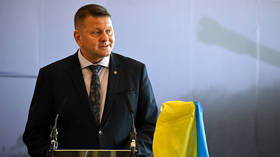UK to double number of drones in Afghanistan

The UK military reportedly aims to double the size of its armed drone fleet in Afghanistan to ten by purchasing five US-made Reaper drones, which for the first time will be controlled from a UK base. The first five were controlled at US stations.
The Royal Air Force (RAF) announced the expedited purchase of the US-made unmanned aerial vehicles (UAVs), with operations set to begin in six weeks, AFP reported. The drones will be flown and operated from a tech hub built 18 months ago in the British region of Waddington in Lincolnshire, a leap forward in technological prowess for the UK. The other five drones the UK operates in Afghanistan were controlled from a US Air Force base in Nevada, and target suspected insurgents in Afghanistan’s southwest province of Helmand. "The new squadron will have three control terminals at RAF Waddington, and the five aircraft will be based in Afghanistan," an RAF spokesperson told the Guardian. “We will continue to operate the other Reapers from Creech though, in time, we will wind down operations there and bring people back to the UK.”It is not known whether the drones will remain in Afghanistan following the NATO withdrawal in 2014. Drone controversy deepensThe use of UAVs in Middle East is a controversial issue, as drones airstrikes frequently kill large numbers of innocent civilians. Last month’s study from Stanford and New York universities titled ‘Living Under Drones’ claimed that only two percent of drone strike casualties in Pakistan are the top militants targeted in the attacks, and that the large number of collateral civilian deaths have turned Pakistanis against the US.The “best available information,” according to the study, is that between 2,562 and 3,325 people were killed in Pakistan from June 2004 through mid-September of this year. An estimated 474 to 881 of those killed were civilians, including 176 children. In early October, Pakistani Interior Minister Rehman Malik said that an overwhelming majority of those killed by US UAV strikes in Pakistan are innocent civilians. Malik asked the US to share its drone technology with Pakistan, claiming his government could do a better job at targeting terrorists than Washington."The Americans themselves often don’t know who they’ve hit,” anti-drone activist and filmmaker Carol Grayson told RT. “And this huge discrepancy over the figures… we’re finding out that a lot more civilians are being killed. But these are the people that the Americans don’t tell you about. And they actually class these people as ‘other.’”The CIA has not responded to these calls for restraint, and recently asked the White House to increase the number of drones it employs, effectively transforming the program into a paramilitary force. This summer, the UN lashed out against US drone policy, and asked Washington to clarify the legal basis for drone strikes against terror suspects rather than trying to capture them. The body argued that the airstrikes, which frequently kill innocent civilians, may be violating international law.The US uses drone technology across the Middle East and North Africa, including in Afghanistan, Pakistan, Iraq, Yemen and Somalia.In the first nine months of 2011, leading up to the ten-year anniversary of the Afghan War, US-led spy drones operating with NATO conducted nearly 23,000 surveillance missions in Afghanistan. At around 85 flights a day, this figure nearly doubles the rate of such missions from two years previous.As the Pentagon increases the number of drones used in NATO missions in Afghanistan, insurgent attacks have risen nearly 50 percent since 2009, according to a media brief released in the fall of 2011 by the Afghanistan International Security Assistance force. The UK has operated UAVs in Afghanistan since 2008 for combat missions and surveillance operations. According to the UK’s Ministry of Defense, Britain’s five drones were flown for 39,628 hours and fired 334 laser-guided missiles and bombs at suspected insurgents.The Ministry of Defense said that it does not know how many insurgents have died from drone attacks because of the risks involved in verifying who has been hit. The ministry also said that it relies on Afghans to handle complaints of civilians killed by such strikes, and gather statistics. Heather Barr, a lawyer for Human Rights Watch, believes this system of verification is flawed because it lacks uniformity, and not all Afghans have ready access to NATO military bases where such complaints can be made. For some Afghans, there is “a certain sense of futility in doing so [reporting civilian deaths] anyway,” due to lack of trust in the West, she said.














